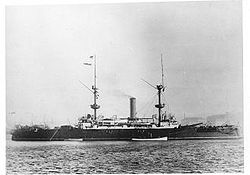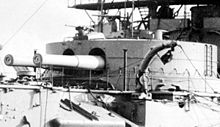Royal Sovereign class
|
HMS resolution
|
||||||||||||||
|
||||||||||||||
|
||||||||||||||
|
||||||||||||||
|
||||||||||||||
The Royal Sovereign class was a class of eight battleships in the Royal Navy .
history
The ships of the Royal Sovereign class were built according to the Naval Defense Act 1889 , which provided for a sum of 21 million British pounds for the fleet expansion. A trigger for the passage of this law were the rumors of a possible Franco-Russian alliance that emerged through joint naval maneuvers in 1888. The law provided for the construction of ten battleships, 42 cruisers and 18 torpedo boats . This meant a significant expansion of the Royal Navy. The so-called “ two-power standard ” was formally laid down in the law. This standard stated that the number of battleships of the Royal Navy should be at least as large as the sum of the number of battleships of the two next smaller naval forces. At the time, these were the fleets of France and Russia .
The core element of the plan were the ships of the Royal Sovereign class. They were the largest and fastest battleships of their time. Like the HMS Dreadnought a generation later, its appearance made all existing battleships obsolete. The design - and its improvement in the form of the Majestic class - determined British battleship building for the next 15 years until the appearance of the dreadnoughts . The Royal Sovereign class is sometimes referred to as the first unit line ship class.
construction
The Royal Sovereign class was designed by Sir William Henry White . It was larger than the Admiral class , Victoria class, and Trafalgar class that preceded it. When the HMS Royal Sovereign was completed, she was the largest warship in the world. At 17.5 knots , she was also the fastest battleship in the fleet. This class established the pattern for the successful battleships of the Royal Navy and other fleets.
The same 34.3 cm (13.5 inch) rear loaders were installed on the Royal Sovereign class as on the Admiral class. On the first seven ships they were mounted in open barbeds. Dispensing with the armored turrets constructed in the 19th century saved weight and enabled a freeboard of almost 6 m, which corresponds to a value of 90% of modern guidelines and significantly improved seaworthiness.
On the second ship of the class, the HMS Hood , the older towers were installed, which were first used in the 1860s. Accordingly, the freeboard was only 3.5 m, the seaworthiness was reduced and led to speed restrictions in rough seas. Otherwise it was identical to its sister ships. This provided a good comparison sample for assessing the suitability of the heavy closed towers on the one hand and the barbeds that are open at the top in practice. The hood was practically unusable in rough seas in the Atlantic and North Sea because the deck was flooded. She was consequently the last British ship to use such a tower construction. All the following ships carried the guns in barbettes. The rotating armored dome mounted over the barbeds also made them appear externally as towers, and so the concept of the tower was transferred from the older constructions to modern armored towers.
The ships were protected by heavy belt armor that was around 2.6 m high and 46 cm thick. The strength of the armor was reduced to 35 cm at the level of the barbeds. The resulting citadel was extended at the top by another 10 cm thick belt. This second belt should protect against light explosive projectiles. It was introduced after attempting shelling on the older ironclad HMS Resistance . Behind the tank were 3 m thick coal bunkers that served as additional protection. The armored deck was 7 cm thick. The strength was reduced to 6.3 cm at the bow and stern. The ship was constructed in such a way that its buoyancy was retained even when the unarmored stern or bow was flooded.
Originally, the equipment was provided with modern 30.5 cm (12 inch) rear loaders. However, since it was feared that these weapons would not be available in time, the old cannons of the previous classes were ultimately used again. The secondary armament consisted of ten 6 inch rapid fire guns for fighting torpedo boats. The secondary armament was distributed over two decks, so that only one cannon could be hit at a time when an enemy hit. In addition to the weight of the guns, the space required to accommodate the crews also had an impact on the total weight. 31 men were needed to operate a cannon: 11 men to directly operate the gun, eight in each of the two ammunition magazines and another seven in the room for storing and preparing the grenades. The secondary armament on the upper deck only had light protective shields attached to the cannons when the ships were commissioned. Between 1902 and 1903 they were built into closed casemates.
The ships rolled hard when the sea was rough. The commander of the HMS Resolution , who came into rough seas in the Bay of Biscay in December 1893 , broke off the voyage and returned to Great Britain. Only the installation of curling keels and the bunkering of coal as ballast (maximum 1,400 t) reduced the rolling to an acceptable level. Nevertheless, the report on the resolution resulted in the nickname Rolling Ressies , which the ships kept throughout their service life .
commitment
The ships of the class were used in the routine service of the Royal Navy and took part in various maneuvers and fleet tours. All ships served in native waters, some also in the Mediterranean fleet . During this mission they took part in the blockade of Crete in 1897/98 . The class as a whole was transferred to the reserve around 1905.
In 1906, with the appearance of the Dreadnought , the class was suddenly out of date. From this point on they were used for less demanding services and from 1909 onwards they were intended for scrapping or for sale. Only two of the ships saw the outbreak of the First World War . The Hood was sunk as a block ship, the Revenge (renamed Redoubtable 1915) took part in the bombardment of the Belgian coast in 1914/15 and was subsequently decommissioned.
Ships of the class
HMS Royal Sovereign
The HMS Royal Sovereign served in the Canal Fleet from 1892 to 1897, in the Mediterranean Fleet from 1897 to 1902, in the Home Fleet from 1902 to 1905 and in the New Canal Fleet from 1905 to 1907. Transfer to the reserve in 1907, scrapped in the material reserve in 1909 and 1913.
HMS Hood
The HMS Hood served from 1893 to 1900 and again from 1901 to 1903 in the Mediterranean fleet and 1903 to 1904 in the Home Fleet . Transfer to the reserve in 1905, then auxiliary service and decommissioning in 1911. Sunk as a block ship in 1914 in Portland Harbor .
HMS Empress of India
The HMS Empress of India (ex Renown ) served in the Canal Fleet from 1893 to 1897, in the Mediterranean Fleet from 1897 to 1901 and in the Home Fleet from 1902 to 1905 . Transfer to the reserve 1905, 1907 to 1912 use in the new Home Fleet, sunk as a target ship in 1913.
HMS Ramillies
The HMS Ramillies served in the Mediterranean fleet from 1893 to 1903, in the reserve fleet from 1893 to 1903 and in the Home Fleet from 1907 to 1911, broken up in 1913.
HMS Repulse
The HMS Repulse served in the Canal Fleet from 1894 to 1902, in the Mediterranean Fleet from 1902 to 1903 and in the Reserve Fleet from 1905 to 1907, afterwards auxiliary services, decommissioned and scrapped in 1911.
HMS resolution
The HMS Resolution served in the Canal Fleet from 1893 to 1901, then various auxiliary services until it was decommissioned in 1911, broken up in 1914.
HMS Revenge
The HMS Revenge (from 1915 HMS Redoubtable ) served in the Flying Squadron as its flagship in 1896, then from 1896 to 1900 the Mediterranean fleet, being the flagship during the blockade of Crete in 1898/99, then the flagship of the Home Fleet from 1902 to 1905 , the canal fleet in 1905 and 1905 various auxiliary services in the fleet reserve until 1913. 1914/15 bombardment of the Belgian coast, decommissioned in 1919, broken up in the same year.
HMS Royal Oak
The HMS Royal Oak served in the Flying Squadron in 1896 , then from 1897 to 1902 the Mediterranean Fleet, 1903 to 1905 Home Fleet , 1905 to 1907 reserve fleet, 1905 to 1907 new Home Fleet. Decommissioned in 1912, broken up in 1914.
literature
- David K. Brown: Warrior to Dreadnought. Warship Development 1860-1906. Chatham, London 1997, ISBN 1-86176-022-1 .
- RA Burt: British Battleships 1889-1904. Naval Institute Press, Annapolis MD 1988, ISBN 0-87021-061-0 .
- Roger Chesneau, Eugene M. Kolesnik (Eds.): Conway's All the World's Fighting Ships 1860-1905. Mayflower Books Inc., New York NY 1979, ISBN 0-8317-0302-4 .
- EHH Archibald: The Metal Fighting Ship in the Royal Navy, 1860-1970. Illustrated by Ray Woodward. Arco Publishing Co., New York NY 1971, ISBN 0-6680-2509-3 .
Web links
Footnotes
- ↑ Conway's All the World's Fighting Ships 1806-1905. P. 32.
- ↑ Other sources assume that the Majestic class was the first unitary ship of the line.
- ↑ Burt p. 85; Conway's All the World's Fighting Ships 1860-1905. P. 33.
- ↑ Burt, pp. 66-67.
- ↑ various squadrons / groups that were deployed around the British Isles, e.g. B. the Channel Fleet or Home Fleet
- ↑ a b Burt, pp. 80-84.
- ↑ Burt, pp. 83-84



